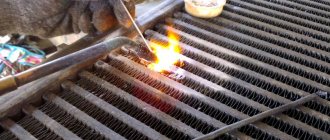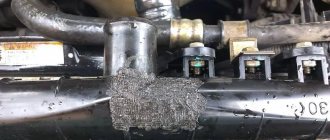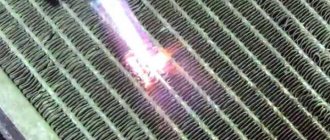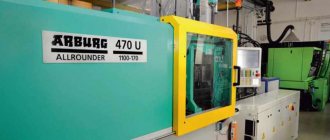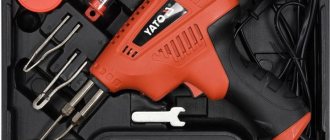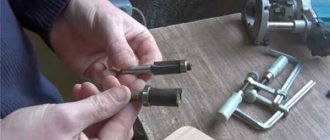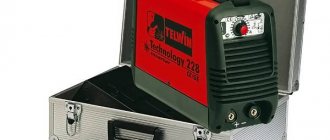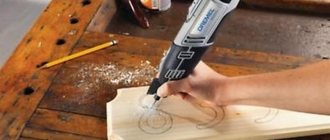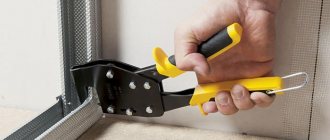Solving the cooling problem
Low-power LEDs, for example: 3528, 5050 and the like, give off heat due to their contacts, and the power of such specimens is much less.
When the power of the device increases, the question of removing excess heat arises. For this purpose, passive or active cooling systems are used. Passive cooling is a regular radiator made of copper or aluminum. There is debate about the benefits of cooling materials. The advantage of this type of cooling is the absence of noise and the almost complete absence of the need for maintenance.
Installation of LED with passive cooling in a spotlight
Active cooling is a cooling method that uses external force to improve heat dissipation. As the simplest system, we can consider a radiator + cooler combination. The advantage is that such a system can be much more compact than a passive one, up to 10 times. The disadvantage is the noise from the cooler and the need to lubricate it.
Purpose of radiators
The purpose of radiators is to remove heat from semiconductors, this helps reduce the influence of temperature on the operating parameters of devices. For this purpose, plate, fin, and pin radiators are used. The larger the radiator, the better it removes heat from radio components, and thus they heat up less.
To improve heat dissipation, it is best to attach the semiconductor device directly to the radiator. If electrical isolation of the semiconductor device from the chassis is necessary, the radiator is mounted on the chassis through insulating gaskets.
The thermal insulation capacity of a radiator depends on the degree of blackness of the material from which it is made. The more blackness, the more efficient the heat removal will be. Let's look at several types of different radiators to understand which radiator to choose for the semiconductor you need.
There are several technologies for making aluminum radiators. But mainly two technologies are used - casting and extrusion. The choice of radiator production is determined by the question: price - quality. Thus, it is cheaper to make finned radiators using the extrusion method, and needle radiators using the casting method.
For example, ribbed radiators will be cheaper and more efficient when produced by extrusion, but needle-shaped radiators can only be produced by casting.
How to fix the LED
There are two main methods of fastening, let's consider both of them.
The first method is mechanical. It consists of screwing the LED with self-tapping screws or other fasteners to the radiator; for this you need a special “star” type substrate (see star). A diode, pre-lubricated with thermal paste, is soldered to it.
On the “belly” of the LED there is a special contact patch with the diameter of a slim cigarette. After that, power wires are soldered to this substrate, and it is screwed to the radiator. Some LEDs go on sale already mounted on an adapter plate, as in the photo.
The second method is glue. It is suitable for mounting through a plate or without it. But it’s not always possible to attach metal to metal; how to glue an LED to a radiator? To do this, you need to purchase a special thermal conductive glue. It can be found both in hardware stores and in radio parts stores.
The result of such fastening looks like this:
How to attach semiconductors to a heatsink
Semiconductors are attached to the radiator using special flanges. If it is necessary to isolate radioelements from the radiator, insulating gaskets must be used. So, of course, the efficiency will decrease, but when using different microcircuits and transistors this is necessary. Another option is to isolate the radiator itself from the board, so as not to use insulating gaskets.
The surface at the point of contact with the radiator must be smooth and clean for better heat transfer. You can also use special thermal pastes to increase efficiency and reduce heat transfer resistance. If you have transistors in a protected housing, then they can be placed on the radiator without gaskets. But you shouldn’t forget about thermal paste.
DIY cooling
The simplest example of a radiator is a “sun” cut out of tin or aluminum sheet. Such a radiator can cool 1-3W LEDs. By twisting two such sheets together through thermal paste, you can increase the heat transfer area.
This is a banal radiator made from improvised means; it turns out to be quite thin and cannot be used for more serious lamps.
It will be impossible to make a radiator for a 10W LED with your own hands this way. Therefore, you can use a radiator from the computer’s central processor for such powerful light sources.
If you leave the cooler, active cooling of the LEDs will allow you to use more powerful LEDs. This solution will create additional noise from the fan and require additional power, plus periodic maintenance of the cooler.
The radiator area for a 10W LED will be quite large - about 300cm2. A good solution would be to use finished aluminum products. You can purchase an aluminum profile at a hardware or hardware store and use it to cool high-power LEDs.
By assembling the required area from such profiles, you can get good cooling; do not forget to coat all joints with at least a thin layer of thermal paste. It is worth saying that there is a special profile for cooling, which is commercially produced in a wide variety of types.
If you do not have the opportunity to make an LED cooling radiator with your own hands, you can look for suitable copies in old electronic equipment, even in a computer. There are several located on the motherboard. They are needed for cooling chipsets and power switches of power circuits. An excellent example of such a solution is shown in the photo below. Their area is usually from 20 to 60 cm2. Which allows you to cool a 1-3 W LED.
Another interesting option for making a radiator from aluminum sheets. This method will allow you to gain almost any required cooling area. Watch the video:
Radiators with forced cooling
There are also radiators that are better forcibly cooled. These can be seen in computer power supplies. With a small area, such radiators dissipate a large amount of power. Their disadvantage is noise during operation and wear and tear on the fans.
They are made from aluminum and its alloys. There are also copper radiators, but their price is much more expensive. But they remove heat much better. And if you have expensive equipment, then to avoid overheating it is better to use copper radiators.
Aluminum fixtures
The most popular LED heat sink is made of aluminum. The main disadvantage of the device is that it consists of a number of layers. This inevitably causes transient thermal resistance, which can be overcome with the help of additional heat-conducting materials: adhesive substances, insulating plates, materials for filling air gaps.
Aluminum radiator for LEDs is used more often than others. It is subject to pressing and does an excellent job of dissipating heat.
An active level of cooling typically requires a flat sheet of aluminum no larger than the size of the luminaire. The sheet is blown by a fan.
The suitable temperature for LED operation is 65 °C. However, the lower the temperature, the higher the efficiency level of the device and the longer its resource. The optimal temperature of the radiator surface is considered to be 45 °C, but not higher. For a 1 W diode, it must be installed on an aluminum radiator. The radiator area is 30-35 cm2. A 3 W LED radiator will require a doubling of area and will be 60-70 cm2.
An aluminum device is best suited as a radiator as it is the lightest and relatively inexpensive. When calculating a device for LED matrices, a proportion of 35 cm per 1 W is taken.
For active cooling systems, the radiator area can be 10 times smaller. A 1 W LED is enough for 3-3.5 cm2.
For example, consider a star radiator for LEDs. The device is used to remove heat from the LED and is a small radiator. It is based on a plate made of a composite material - aluminum is used, which removes heat from the LED, and copper foil with contact pads. The radiator is mounted on LEDs with a high power rating (1-3 W).
LED lamps with cooling radiator: types of radiators
LED lamps with a cooling radiator: types of radiators
LED lamps have firmly entered our lives, almost completely replacing incandescent lamps and energy-saving compact fluorescent lamps (CFLs). It can be assumed that the whole point is their cost-effectiveness, excellent technical characteristics (such as luminous flux, CRI, scattering angle), as well as their long service life.
Why do you need a radiator in an LED lamp?
The service life of the product is primarily influenced by the quality of the LEDs, as well as the driver, the correct operation of which directly affects the stability of the diodes.
However, during the operation of an LED lamp, its surface becomes dirty, which negatively affects the removal of the generated heat. Over time, the problem of overheating appears, which is associated with a decrease in the light output of the diodes until they fail.
To avoid this, increase the stability of the light sources. For this purpose, a radiator is provided in the design of each of them.
Types of radiators
A radiator is a structural element that serves to remove and dissipate heat from LEDs.
LED lamps with radiator cooling
LED lamps with a cooling radiator come in the following types:
- with aluminum radiator;
- ceramic;
- composite;
- plastic.
LED lamps with aluminum heatsink
These lamps belong to the standard or high class. The aluminum radiator in such products can be either a strip of metal or a structurally more complex aluminum base. Hence the division of such lamps into two types:
- with finned radiator;
- with a flat radiator.
LED lamps with finned aluminum heatsink
The most effectively protected lamps, the radiator of which is presented in the form of a multilayer structure with ventilation ducts. Due to them, the area of heat dissipation increases, which significantly increases the service life of LEDs, and also prevents their degradation over time due to overheating.
LED lamps with aluminum heatsink
Lamps with flat radiator
A flat radiator is less efficient than a finned one. Such a cooling element is used mainly in low-power lamps. Often, for more efficient heat removal, it has ventilation channels, and its dielectric surface is covered with a layer of special paint or varnish.
Composite radiator
LED lamps with a cooling radiator made of composite material are distinguished primarily by their affordable price. In such lamps, the element is a two-layer structure made of an aluminum strip coated with heat-conducting plastic.
Due to their low price, lamps with a composite radiator are the most widely represented on the market in the economy class segment.
However, such radiators cannot effectively remove heat, so the warranty period for products with them rarely exceeds 1 year.
Plastic radiator
The simplest option, it would be more correct to call it an imitation of a radiator. The element is a housing made of heat-dissipating plastic. The main differences between such lamps: low price, short warranty period, short service life (10,000-15,000 hours). In high-power lamps, to increase heat dissipation, the plastic radiator is made with additional massive fins and ventilation holes.
LED lamps with plastic radiator
Ceramic radiator
LED lamps with a ceramic cooling radiator are distinguished by high heat resistance, and the dielectric properties of the material allow LED modules to be mounted directly on the surface of such a radiator. The most common type of lamp with a ceramic radiator without a diffuser bulb is the so-called corn lamp.
LED lamps with ceramic cooling radiator
LED lamps with which cooling radiator to choose?
From all of the above, we can conclude that the quality of any LED lamp depends, among other things, on the quality of the radiator, or rather on the material from which it is made.
The most reliable, with a long actual service life, are considered to be LED lamps with an aluminum cooling radiator, as well as with a ceramic one (if such a light source does not have a diffuser bulb).
Plastic options can be preferred if such lamps will be used only occasionally and for a short time, for example, in closets and utility rooms.
Radiator for LEDs: purpose, types, do it yourself
When assembling an LED device, it is important to correctly select, design and install a system for cooling it - a radiator for LEDs. If the thermal mode for LED operation is selected incorrectly, this will subsequently lead to its overheating and failure.
Why do you need to cool the LED?
The opinion that the LED does not heat up is wrong. It is based on the fact that when you touch such a low-power device, you do not feel heat. According to the law of conservation of energy: energy does not appear out of nothing and does not disappear without a trace, but is transformed from one type to another.
LEDs, as solid-state light sources, emit the visible part of the spectrum and generate heat. Due to thermoelectric phenomena occurring in semiconductor LEDs, heat is generated. In direct proportion to the heating temperature of the LEDs, its indicators and characteristics change.
Such a strong dependence of indicators on temperature leads to the following:
Rice. 1. Graph of relative luminous flux versus junction temperature (MKR LED)
- When the LED crystal is heated, the semiconductor junction degrades, and it quickly wears out and its service life decreases;
- The thermal threshold for LEDs, after which breakdown occurs, is reached after the temperature rises to 150°C. Depending on the materials used, the amount of luminous flux and wear life change;
- the amount of light flux gradually decreases, which is reflected in the dependence curves shown in Fig. 1;
- As the temperature changes, the forward voltage drop across the LED also changes. As the light source heats up, the forward voltage drop increases. The curves depict this dependence on the graphs.
The reasons listed above are a serious reason to ensure that heat is removed from the LED device.
How to cool an LED
An effective way to cool the crystal is to remove excess heat using the phenomenon of thermal conductivity.
In radio electronics, radiators are used for heat removal, with the help of which heat is removed into the atmosphere in two ways. With the first cooling method - passive, one part of the thermal infrared waves is emitted into the atmosphere, and the second leaves due to the convection of warm air from the radiator (Fig. 2).
In low-power LEDs, with this passive method of thermal convection, heat is conducted through metal contacts, the thermal conductivity of which allows a sufficient amount of excess heat to be removed from the crystal. Longer pins allow for better heat dissipation and dissipation throughout the board.
The disadvantage of the passive method is the large size, weight and high cost of the installed heat sink.
Rice. 2. Passive method of thermal convection
Turbulent convection refers to the second active cooling method. To remove heat from high-power LED devices, a crystal mounted on a substrate is fixed to the radiator.
The dimensions, shape and number of radiator fins directly depend on the diode power. The system has built-in mechanical devices and fans that create active air flows (Fig. 3). For example, 20-watt lamps in the headlights of business-class cars are forced to be blown by built-in coolers. This method is more productive, but is applicable only in good weather conditions and the room is not very dusty.
Fig.3. Fans for active cooling
Installing a radiator reduces the process of overheating of the LED, which allows you to increase its service life several times.
Types of radiators
Before assembling the device, you need to decide on the type of radiator used:
- pin or needle (Fig. 5);
- ribbed (Fig. 4).
If natural cooling of the light source is necessary, the first type is used, and in the case of forced cooling, the second type is used. Typically, the pin type, with the same dimensions as the ribbed one, is 70% more productive.
Fig.4. Radiator ribbed
A fin-type radiator is mainly used with an active method of heat removal. But with certain geometric parameters it is used in a passive way.
Fig.5. Needle radiator
When the distance between the needles is 4 mm, the device is intended for natural heat dissipation, and when the gap is 2 mm, the radiator is equipped with a fan.
Radiator materials
For long and productive operation of the LED, it is very important to choose high-quality material for the radiator. It is selected according to certain requirements and indicators. The thermal conductivity indicator should be within 6-10 W. At a lower rate, the material will not conduct heat that enters the air.
If the thermal conductivity is higher than 10 W, the operating efficiency of the device in terms of technical indicators will not increase, and the cost of the material will be a waste of money. The most suitable materials for production are considered to be aluminum, ceramics, and copper.
In rare cases, the device is made from materials that include plastics that help dissipate heat.
LED heatsinks are most often made of extruded aluminum because it dissipates heat better than other materials. The main drawback of an aluminum radiator for LEDs is the large number of layers in the product, which contributes to the appearance of transient thermal resistance. To overcome such resistance, it is necessary to add materials to the product that have thermal conductive properties and fill air gaps: adhesives, insulating plates, etc.
Cooling features of high-power LEDs
As mentioned earlier, effective heat removal from the LED can be achieved by organizing passive or active cooling. It is advisable to install LEDs with a power consumption of up to 10 W on aluminum (copper) radiators, since their weight and size indicators will have acceptable values.
The use of passive cooling for LED arrays with a power of 50 W or more becomes difficult; The dimensions of the radiator will be tens of centimeters, and the weight will increase to 200-500 grams. In this case, it is worth considering using a compact radiator together with a small fan. This tandem will reduce the weight and size of the cooling system, but will create additional difficulties. The fan must be provided with the appropriate supply voltage, and care must also be taken to protect the LED lamp in the event of a cooler failure.
There is another way to cool powerful LED matrices. It consists of using a ready-made SynJet module, which looks like a cooler for a medium-performance video card. The SynJet module features high performance, a thermal resistance of no more than 2 °C/W and a weight of up to 150 g. Its exact dimensions and weight depend on the specific model. Disadvantages include the need for a power source and high cost. As a result, it turns out that a 50 W LED matrix must be mounted either on a bulky but cheap radiator, or on a small radiator with a fan, power supply and protection system.
Whatever the heatsink, it can provide good, but not the best, thermal contact with the LED substrate. To reduce thermal resistance, heat-conducting paste is applied to the contacted surface. The effectiveness of its impact has been proven by its widespread use in cooling systems for computer processors. High-quality thermal paste is resistant to hardening and has low viscosity. When applied to a radiator (substrate), one thin, even layer over the entire contact area is sufficient. After pressing and fixing, the layer thickness will be about 0.1 mm.
Finned radiator
Ribbed (plate) radiator. The area of these radiators is equal to the sum of the areas of all sides. The larger the surface area, the higher the heat transfer efficiency. To improve cooling of the elements, it is necessary to increase the radiator area. And in order not to increase the size, since this is not always possible due to the design of the device, radiators are made with ribs and micro-relief on them. The number of fins and their sizes significantly increase the area of the radiators.
Also, radiators with fins differ in the distance between the fins. On radiators where the distance between them is small, you need to install forced cooling. Such radiators are found in computers to cool processors. Radiators with a large distance between the fins are used without fans. Although the former can also be used without forced cooling. Here you can see how efficiently they will work with and without cooling.
An improved plate heat sink is a set of several plates bent in different directions. This radiator, with a surface area equal to the simplest plate one, has smaller dimensions. This heat sink is installed similarly to a plate heat sink. The number of plates may vary depending on the required surface. The dissipation area of such a radiator is equal to the sum of the areas of all curved sections of the plates, plus the surface area of the central part. This type of radiator also has disadvantages: reduced efficiency of heat removal from all plates, as well as the impossibility of obtaining a perfectly straight surface at the junction of the plates.
HOW TO CALCULATE A RADIATOR FOR AN LED
The calculation of a radiator for an LED is carried out not by the surface area, but by the useful dispersion area. The larger it is, the more intensely the device will transfer heat to the air. It is also necessary to take into account the power input. If the LED is used at full power, then it will need more cooling
It is equally important to consider where the device will be located: outdoors or indoors
The professional calculation method takes into account several important factors:
- ambient air indicators;
- radiator modification;
- heat sink material;
- dispersion area.
But such characteristics are usually taken into account by designers who develop a heat sink. At home, you can use a simpler formula. It involves calculating the maximum power dissipation of the heat exchanger.
Ф = а · S · (Т1 – Т2),
where F is the magnitude of the heat flow, S is the surface area of the radiator (all heat-removing surfaces), T1 and T2 are the temperature of the medium that removes heat and the temperature of the heated surface, respectively, and is the heat transfer coefficient (conventionally assumed to be 6-8 W/m2 K) .
When calculating the surface area of a heat sink, the following must be taken into account:
- Plate and fin radiators have 2 surfaces for heat removal, so in the formula it will not be S, but 2S.
- For needle radiators, the heat sink surface area is determined as the circumference (π · D) multiplied by the height (H).
There is a simpler formula for calculating the radiator area for an LED, which is popular among Internet users as experimental. It is applicable for aluminum radiators and looks like this:
Soх = (22 – (M 1.5) W,
where Sox is the area of the cooler, M is the unused power of the LED (W), W is the supplied power (W). The area obtained from the formula is sufficient for natural cooling of the LED without the use of a cooler. Using the formula for calculating a copper radiator, the area must be reduced by 2 times.
You can avoid calculating the LED cooling radiator, but use average data that reflects the dependence of area on power. For aluminum radiators, the following values are relevant:
- 1 W – 10-15 cm2;
- 3 W – 30-50 cm2;
- 10 W – 1000 cm2;
- 60 W – 7000-7300 cm2.
The indicated area of the LED heatsink has a fairly large scatter, so the data is considered approximate, which must be taken into account when choosing a suitable device
Pin radiator
A pin (needle) heat sink is a very effective heat sink for semiconductor devices. They are made of duralumin with a thickness of 4-6 mm and aluminum wire with a diameter of 3-5 mm. On the surface of the pre-processed radiator plate, you need to mark with a center punch the locations for the holes for the pins, terminals of transistors, diodes and mounting screws.
The distance between centers should be equal to 2-2.5 times the diameter of the aluminum wire used. The diameter of the holes for the pins is chosen so that the wire fits into them with the smallest possible gap. On the reverse side, the holes for the pins are countersunk to a depth of 1-1.5 mm. With a minimum volume, such a radiator has a maximum effective dissipation area. The surface area of such a heat sink is equal to the sum of the areas of each pin and the area of the main body.
You can also buy ready-made radiators both in the store and on the market. I buy them at the market - flea market, where they cost five times cheaper than in the store. There is a large selection and you will not have any problems which radiator to choose for your craft.
How to connect a HPS lamp
Here is a compact shield assembled with your own hands, according to the connection diagram.
You can, of course, assemble all this in the overall body of the lamp, if the dimensions allow.
It is very important, before assembling such a circuit yourself and using any components, using a conventional multimeter in the maximum resistance measurement mode, check the insulation of the inductor and capacitor. Is there a hole in the body? Is there a hole in the body?
Is there a hole in the body?
To supply and disconnect 220V power, use a two-pole input circuit breaker.
For one lamp with a power of up to 400W, a machine with a nominal value of 5-6A is quite suitable. In addition to on-off switching operations, it will also play the role of a protective device.
A circuit breaker is mounted at the very beginning of the circuit. Do not forget to also ground the entire panel body.
Two neutral wires come out of the machine. According to the diagram, one of them is connected directly to the lamp, and the second one is connected to the corresponding terminal labeled “N” on the starter.
Keep in mind that the choke must be installed only in the open phase wire going to the lamp, and not in the neutral wire.
Otherwise, you can accidentally burn the product if during operation the neutral wire after the ballast choke accidentally shorts out. Next, turn off the phase. Mount one wire from the machine to the incoming contact of the throttle.
And connect the wire from the output contact to terminal “B” (Balast) of the ballast.
After that, connect the middle terminal Lp (Lampa) to the light bulb socket.
IZU switching circuits
Let's consider the parallel launch scheme of the IZU. In such a circuit, the lamp current does not pass directly through the IZU, which virtually eliminates any power loss. The circuit of the ignition device for such inclusion is quite simple, the devices themselves are inexpensive, easy to operate and quite reliable. However, high-frequency pulses generated by the ignition device in such a circuit affect, in addition to the lamp, also the choke, which necessitates the use of chokes with increased insulation, resistant to voltages of 2–5 kV.
Since standard chokes for metal halide and sodium lamps do not support this voltage value, the parallel IZU switching circuit is used only with lamps whose ignition voltage is less than 2 kV. First of all, such lamps include high-power metal halide lamps (from 2000 to 3500 W).
We calculate the radiator area
Please note that to correctly calculate the radiator area, the parameters of the useful dissipation area, and not the surface area, are taken into account. When calculating the usable area (S), the sum of the areas of the ribs and the substrate in square meters is included
It should be taken into account that each rib has two outlet surfaces. In this case, S of a rectangular heat sink S - 1 cm2 is - 2 cm2
When calculating the usable area (S), the sum of the areas of the ribs and the substrate in square meters is included. It should be taken into account that each rib has two outlet surfaces. In this case, S of a rectangular heat sink S - 1 cm2 is - 2 cm2.
As a result of the experiments, a formula was derived for calculating the required heat sink area:
S = (22 – (M x 1.5)) x W, in which
S – radiator heat sink area; W – power supplied (W); M – LED power. For plate radiators made of aluminum, the following approximate data calculated by experts from Taiwan can be used:
- 1 W: 10 ÷ 15 cm2;
- 3 W: 30 ÷ 50 cm2;
- 10 W: approximately 1000 cm2;
- 60 W: 7000 73000 cm2.
Since the range of the indicated data has a wide range and they were determined in conditions for the climate of a southern country, the values are not absolutely accurate and are suitable for preliminary calculations.
More detailed information on calculating the radiator area can be obtained by watching the video.
How to fix the LED
There are two main methods of fastening, let's consider both of them.
First way
- it's mechanical. It consists of screwing the LED with self-tapping screws or other fasteners to the radiator; for this you need a special “star” type substrate (see star). A diode, pre-lubricated with thermal paste, is soldered to it.
On the “belly” of the LED there is a special contact patch with the diameter of a slim cigarette. After that, power wires are soldered to this substrate, and it is screwed to the radiator. Some LEDs go on sale already mounted on an adapter plate, as in the photo.
Second way
- it's adhesive. It is suitable for mounting through a plate or without it. But it’s not always possible to attach metal to metal; how to glue an LED to a radiator? To do this, you need to purchase a special thermal conductive glue. It can be found both in hardware stores and in radio parts stores.
The result of such fastening looks like this:
DIY: Water Cooled Powerful LED
- Jurei-678
- October 6, 2016
- Homemade productsLight
We have a new addition to the section of useful homemade crafts: a powerful DIY water-cooled LED. Hi all! Sometimes you want to build a powerful LED lamp, but there is no suitable radiator or they are expensive and bulky.
Today I will show you how to cool a powerful 10-30 watt LED with a three by three centimeter radiator. We take the radiator and glue the LED onto it; as soon as the glue has dried, we apply colorless silicone to the LED and glue a piece of glass or lens onto it.
We also seal the negative and positive terminals with silicone; when the silicone dries, we lower the structure into a glass of water and check the water resistance between the conductors with an ohmmeter - it should be very high. We lower the LED into a 200 gram jar of water or oil, make a hole in the lid and turn on the power. After an hour of operating the lamp at 1000 mA, the water temperature rose from 19 to 21 degrees. An LED with a radiator can be glued directly to the bottom of the can, and an E 14 or E 27 socket can be attached on top - you can screw it into the chandelier by first converting the power supply to 12 volts. With such cooling, the LED does not blind as much as without water! Very pleasing to the eyes. If you add aromatic liquid to the oil, it will smell pleasant when illuminated.
Author of the article “Do it yourself: powerful water-cooled LED” Jurei-678
Heat
To measure the heating of Philips Z ES LEDs, I heat the samples for 60 minutes. Unlike the original Philips Ultinon car lamps, Smart H7 also has a flexible radiator. Therefore, the service life of Smart will be approximately 2 times longer than that of real Philips Ultinon.
I take measurements near the LEDs on the plate. There were already holes for installing a temperature sensor on the copper board. I just used a file to make a groove for the thermocouple wire to come out.
The assembly and materials turned out to be very good, they did not skimp on thermal paste, this rarely happens. The diodes are on a copper plate, not an aluminum one. The thermal conductivity of copper is almost 2 times higher, and it is much more expensive than aluminum. The flexible part of the radiator is crimped with copper and placed on heat-conducting glue, so it is glued well. The petals are pressed very tightly, I tried to loosen them, but it didn’t work.
In cheap car lamps, the petals sometimes dangle, are connected to the body loosely or without thermal paste. The flexible petals even fell out of the car light bulb when trying to install them in the headlight.
For the most part, I am a supporter of a passive cooling system for LED lamps for cars. Passive cooling is more universal and is applicable not only to closed low-beam or high-beam headlights. Passive can be installed in foglights (abbreviated PTF) and other unprotected places. The simpler the cooling, the more reliable it is. Car LED lamps with a passive radiator are of course more difficult to install, but this can be solved with a set of additional covers. Enlarged rubber covers hide a massive rigid or flexible radiator without interfering with the operation of the electric corrector or hydraulic headlight angle corrector.
I have higher requirements for cooling with a fan, because problems with heat dissipation are much more common. Usually such models look decent on the outside, but when you figure it out, there are big problems inside,
Raw material
Aluminum is most often used to make heat sinks these days. The thing is that this material is very convenient for such purposes, and at the same time quite cheap. But if the dimensions of the product matter, then it is unlikely that you will be able to find anything better than copper, since it has greater heat conductivity, which means the heat sink will be 2 times smaller in size.
But not only these two materials are suitable for making a cooling device? It makes sense to understand what other raw materials a heat sink can be made from and what their differences are.
Aluminum
Aluminum radiator
In terms of thermal conductivity, the average value ranges from 200 to 240 W/m*K, which is almost 3 times higher than the same parameter for brass and iron. It mainly depends on the presence and amount of impurities in aluminum. Of course, this is an easy-to-process metal, which is why it is so common, but still, provided that the device body is small and decent cooling is required, an aluminum radiator is inferior to copper.
Copper
The indicator of this metal is 2 times higher than the thermal conductivity of aluminum, second only to such a noble metal as silver, and amounts to 400 W/m*K. But despite the fact that copper cools so well, such radiators are quite rare. The thing is that it is quite expensive when compared with aluminum, and besides, it is difficult to machine and has a large mass.
Copper radiator
It turns out that if copper coolers are installed in an LED lamp, its price will increase, and this is unacceptable, because as a result, the company will become uncompetitive in a tough market.
Ceramics
The thermal conductivity parameter is close to the parameters of aluminum and amounts to 175–235 W/m*K. Ceramics are convenient because they themselves are dielectrics, which is important in electronic and electrical circuits.
And yet, with such thermal conductivity, it loses to another material that is very easy to handle.
Thermoplastic
Of course, the thermal conductivity parameters of thermoplastic are slightly lower than those of aluminum (from 5 to 40 W/m*K), but it has some advantages. In addition to its dielectric properties, it is also very light and low cost. Only when designing LED lamps more powerful than 10 watts, it clearly loses to aluminum and copper.
Why is it needed?
Along with other semiconductor devices, the LED is not an ideal element with 100% efficiency. Most of the energy it consumes is dissipated into heat. The exact efficiency value depends on the type of emitting diode and its manufacturing technology. The efficiency of low-current LEDs is 10-15%, and for modern white ones with a power of more than 1 W, its value reaches 30%, which means that the remaining 70% is spent as heat. Whatever the LED, for stable and long-term operation it requires a constant removal of thermal energy from the crystal, that is, a radiator. In low-current LEDs, the radiator function is performed by the leads (anode and cathode). For example, in SMD 2835 the anode lead takes up almost half of the bottom of the element. In high-power LEDs, the absolute value of power dissipation is several orders of magnitude greater. Therefore, they cannot function normally without an additional heat sink. Constant overheating of the light-emitting crystal significantly reduces the service life of the semiconductor device and contributes to a gradual loss of brightness with a shift in the operating wavelength.
What kind of heatsink is needed to cool an LED?
LEDs, which appeared on the radio electronics market relatively recently, have already firmly taken a leading position in relation to other light sources. They are the most economical in terms of energy consumption, more compact and convenient to use and have less heat generation.
And yet, no matter how high-tech the LED is, an increase in temperature during its operation cannot be avoided. In addition, when heated, such an LED element, due to its design features, begins to lose its luminous flux.
Of course, if it is a regular DIP LED with two contact legs, external cooling is quite enough for it. But if we take more powerful elements, then it’s worth thinking about a cooling radiator for LEDs, which would help remove heat from the light source.
If you pay attention to similar cooling devices in stores, you can understand how high their cost is. What to do then?
It remains to figure out whether it is possible to make a radiator for a specific LED or group of LEDs yourself, how to do it, and how difficult it is. Now we will try to resolve this issue.
Do you need a radiator?
To begin with, it makes sense to understand whether a cooling radiator is needed for an LED and, if so, why.
The fact is that in terms of efficiency, if we take low-current diode emitters, their efficiency is only 15–17%. It is clear that the rest of the energy will be spent on heat generation. Of course, the efficiency of more powerful LEDs (more than 1 watt) is 2 times higher, but they also consume more energy.
So any such lighting device ultimately releases a certain amount of heat, which must go somewhere. For example, in the SMD2835 light diode, the anode contact makes up slightly less than half of the component; it provides the necessary heat dissipation, and this despite the fact that it is low-current. It turns out that it already has a radiator. But powerful LEDs require more attention.
When the crystal temperature is constantly increased, the wavelength of the radiation shifts, resulting in reduced brightness and greatly reduced service life. It turns out that there is no way to do without a radiator when independently installing a circuit using powerful LEDs.

